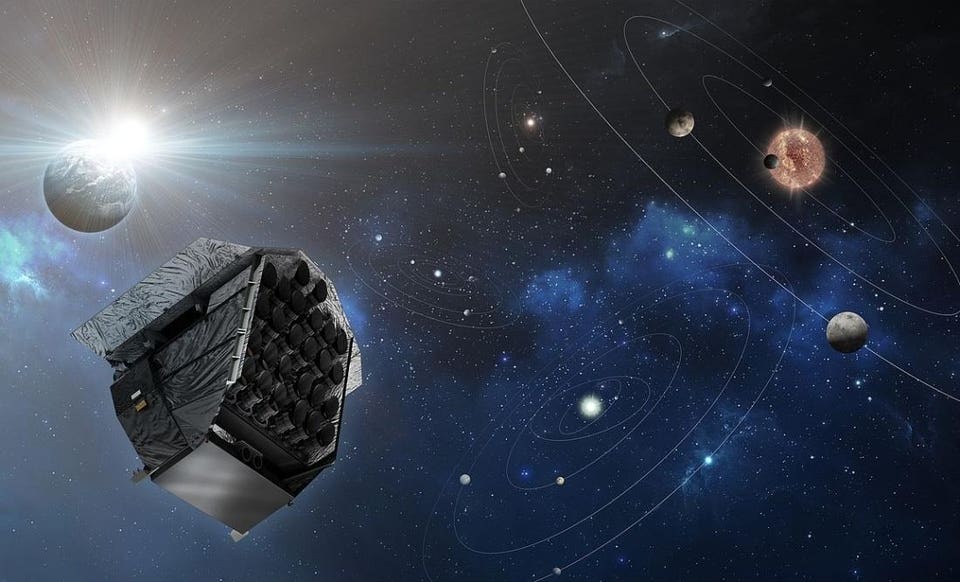Artist’s illustration of the European Space Agency’s PLATO spacecraft in full operation. After nearly thirty years of extrasolar planet hunting, finding an earth-like planet orbiting another sunlike star remains elusive. But at the end of 2026, the European Space Agency is launching a large multi-element space telescope that over its 4.
5 to 8 year observing life should go a long way in answering just how common extrasolar earths truly are. PLATO, the PLAnetary Transits and Oscillations of stars mission will address such fundamental questions as: How do planetary systems form and evolve? Does the frequency of terrestrial planets depend on the environment in which they formed? PLATO will also provide new data on the stellar physics of a plethora of solar type stars, but that’s the subject of a future post. PLATO will have a huge field of view; in one single field, there are about 300,000 targets, Isabella Pagano, a PLATO co-principal investigator and director of the Catania Astrophysical Observatory, part of the Italy’s National Institute for Astrophysics, told me in her office in Sicily.
Most of its star catalog will lie within a few hundred to few thousand light years away. The current version of the PLATO input catalog contains about 180,000 stars in the PLATO field South which has been already selected and will be observed for at least 2 years, Marco Montalto, a Catania Astrophysical Observatory astrophysicist and PLATO mission member, told me in Sicily. But the most likely options are either keep observing the same field and the same stars or to observe also another field in the North which will bring the total number of stars to about 360,000, he says.
PLATO Will Have A Prime Vantage Point From the gravitationally stable Earth-Sun Lagrangian Point 2, some 1. 5 million km away, PLATO will scour a large number of preselected solar type stars including a few red dwarfs looking for the telltale signature of an earth-like planet as it moves across the face of its parent star. PLATO really has no instruments; only 26 camera elements that will collect photons, for photometry, the measurement of the intensity and brightness from a given celestial target.
For its planet-hunting activity, the mission is looking to detect dimming in the target star’s brightness caused by a terrestrial mass planet passing across the face of its parent star. Although it only takes 12 hours for an earthlike planet to transit across the face of a sunlike star, astronomers need at least two full transits to confirm that an earth-sized planet is really circling its star. Searching For The Telltale Dimming Caused By A Transiting Earth You want to observe the objects for as long as possible; this allows you to detect possible planet transits with periods of orbits that are comparable to a planet like our Earth, Enrico Corsaro, a Catania Observatory astrophysicist and PLATO science consortium member, told me in Sicily.
You basically need to have to see the planet transiting around the star at least twice; I say twice, because if it happens once, it could just be a spurious event, he says. During its mission, PLATO is expected to characterize hundreds of rocky planets circling other stars, including a few earth twins, says ESA. The mission should be able to determine the planets’ bulk properties to help determine their potential habitability as well as the overall architecture of their planetary systems, notes ESA.
Despite decades of observations, astronomers still haven’t found a solar system with an architecture much like ours. that is, with a Jupiter mass planet at a Jupiter-like distance from its parent star and an inner solar system circling a normal sunlike g-type yellow dwarf like our own. that’s most likely due to observational bias; the fact that until now we’ve been hamstrung by the limitations of both ground and space-based observatories.
But the mission should change the planet-hunting paradgim in part through measuring their host stars’ masses, radii, and ages to a precision of within ten percent, says ESA. PLATO will also offer ultra–high precision, long (at least two years), uninterrupted photometric monitoring in the visible band of very large samples of bright stars, the space agency notes. The frequency of earthlike planets in the habitable zone around a star like the Sun is very uncertain; it could be thirty to sixty percent, says Montalto.
We still know very little about the population of exoplanets around sunlike stars. There are more than 4000 planetary systems that we know of today and we cannot say that there is a real solid solar system analog among them, says Pagano. Following In Galileo’s Footsteps Even so, here in Catania where the night skies can often be extraordinary, there’s a certain synergy for the hunt for planets around nearby stars.
That could be in part because astronomical culture in Italy itself harkens back nearly 500 years to the days of Italian philosopher and early cosmological theorist Giordano Bruno who posited that we live on but one of many such habitable planets in the greater cosmos. But it was Galileo Galilei who in the same era championed scientifically rigorous observations of our own solar system. Pagano says a key difference between Galileo and previous sky observers in Europe at least was that Galileo recorded his observations in a scientific manner with the date, time and often even illustrations.
This was an early turning point in understanding our place in our solar system and in the greater cosmos. As for PLATO’s ultimate exoplanetary legacy? A statistically large sample has never been obtained for extrasolar terrestrial planets, but in the end, we’ll have a complete picture of where planets are being formed, says Montalto. .
From: forbes
URL: https://www.forbes.com/sites/brucedorminey/2023/12/19/esas-next-planet-hunting-mission-should-finally-find-earths-twin/



